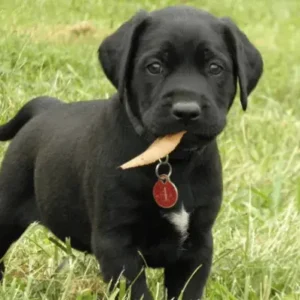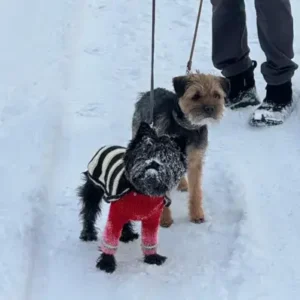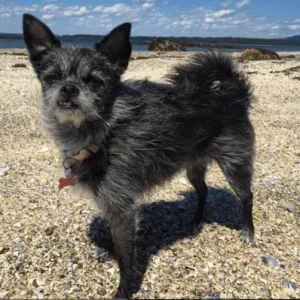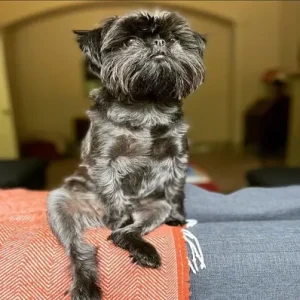Black Russian Terrier History/Origin
In the 1930s, the Soviet government established the Red Star Kennel near Moscow, where scientists and breeders set out to create a “superdog” for the Russian army. The task was challenging, as the aftermath of the Russian Revolution, two world wars, and economic crises had decimated Russia’s best purebred dogs.
With imports nearly impossible, the Red Star team started from scratch, combining 17 breeds, including Giant Schnauzer, Airedale Terrier, Rottweiler, and a touch of Newfoundland to balance temperament.
After World War II, quality dogs brought from Germany reinvigorated the program. The result was the Black Russian Terrier (BRT), a powerful, tireless dog capable of patrolling Russia’s vast borders, subduing prisoners in Stalin’s prison camps, and surviving harsh Siberian winters. Despite the name, the BRT is only 15-30% terrier in its genetic makeup.
By the mid-1950s, with the decline of Stalin-era gulags, the army began selling surplus litters to breeders and enthusiasts. Retired officers also brought their K-9 companions into civilian life, helping to popularize the breed. The BRT earned the nickname “Black Pearl of Russia” and became a cherished guardian for families.
In 1981, it was officially recognized as a breed by the Soviet Ministry of Agriculture, and in 2004, it was admitted to the AKC Stud Book and then under the Working Group. Today, the BRT is more commonly found guarding suburban homes than political prisoners.
Black Russian Terrier Personality
Black Russian Terriers are calm, confident, and courageous dogs with incredibly stable temperaments. They radiate tranquility and self-assurance, traits rooted in their military heritage. Loyal and protective, they may seem aloof toward strangers but are deeply affectionate with their families.
Known as natural guardians, their emotional stability ensures they remain composed and trustworthy. Highly intelligent, they thrive on structure and perform best when given a job or purpose, making training relatively easy. Blackies are excellent with children and instinctively protect those in their circle.
- Potential Challenges
A Black Russian Terrier’s temperament is shaped by heredity, training, and socialization. Puppies with good temperaments are curious, playful, and eager to engage. While meeting parent dogs or siblings can provide clues about a puppy’s potential behavior, it’s not a guarantee.
Early socialization is essential to help them grow into confident, well-rounded adults. They may develop overprotective or reserved tendencies without exposure to diverse people, environments, and situations.
Some Blackies are selective about other dogs, often preferring canine companions within their household. Enrolling in puppy kindergarten and introducing them to visitors, busy parks, and dog-friendly stores can significantly improve their social skills.
These dogs require consistent attention and guidance, as neglect can lead to withdrawal or behavioral issues. With proper training and socialization, Blackies become well-mannered pets making them an exceptional dog breed for families seeking a protective companion.
Black Russian Terrier Physical Appearance
The Black Russian Terrier is a large, robust, and strong breed. Its body length is well-proportioned to its height at the withers, giving it a square appearance, complemented by a high-set tail. The back is level but not flat, while the forelegs are straight and well-formed, supported by large, muscular, sloping shoulders.
- Size
According to breed standards, Black Russian Terriers are a large and robust breed, standing between 26 to 30 inches tall at the shoulder. They can weigh anywhere from 80 to 130 pounds, with males generally being larger than females. Their impressive size, combined with their powerful build, makes them both formidable guard dogs and gentle family companions when properly trained and socialized.
- Coat color
Blackies have a predominantly black coat, though a touch of gray hair may appear, even in puppies. Their double-layered coat has a coarse outer layer and a soft, thick undercoat. The length of the coat ranges from 1.5 to 4 inches, giving it a tousled appearance, which some might describe as wiry or curly.
Black Russian Terrier- Source: black_russian.terrier
Black Russian Terrier Gender Differences
In the Black Russian Terrier breed, there is typically a size difference between males and females. Males are generally larger, standing between 28 to 30 inches tall and weighing between 110 to 130 pounds. Females are slightly smaller, usually around 26 to 28 inches tall and weighing between 80 to 100 pounds.
Both genders of Black Russian Terriers share a strong, muscular build and similar characteristics. However, males tend to have a more dominant and protective demeanor. Females, on the other hand, are often more balanced in temperament.
Black Russian Terrier Feed/Nutrition
When feeding your Black Russian Terrier, they typically require 3 to 4.5 cups of high-quality dry food per day, divided into two meals. The amount your dog needs can vary depending on factors such as size, age, build, metabolism, and activity level. Just like people, each dog is an individual and may have different food requirements. For example, a highly active dog will need more food than a less active dog.
Additionally, the quality of dog food matters—better food provides more nourishment, meaning you’ll need to feed your dog less. To keep your Blackie in good shape, it’s best to measure their food and feed them twice a day, rather than leaving food out all the time. You can also add fruits like strawberries to your dog’s diet as healthy treats, but always make sure they’re safe and in moderation.
Black Russian Terrier Health
Blackies are generally healthy, but like all breeds, they’re prone to certain health conditions. Not all Blackies will get any or all of these diseases, but it’s important to be aware of them if you’re considering this breed. Here are a few conditions you and your vet should keep an eye out for:
- Allergies: Black Russian Terriers can suffer from food, contact, and inhalant allergies. Food allergies may cause skin or digestive issues, while contact allergies result from reactions to substances like bedding or shampoos, and inhalant allergies come from airborne irritants such as pollen or dust. Prevention includes identifying and avoiding allergens, feeding a balanced diet, and using hypoallergenic products.
- Hip Dysplasia: Hip dysplasia is an inherited condition where the thighbone doesn’t fit well into the hip joint, leading to pain, lameness, and eventually arthritis. Some dogs may not show signs until they are older, making early detection crucial. Prevention involves regular vet checkups, maintaining a healthy weight, and avoiding excessive exercise during growth stages. X-ray screening can help detect hip dysplasia early.
- Elbow Dysplasia: Elbow dysplasia is caused by abnormal joint development, leading to a malformed and weakened elbow joint. This can result in arthritis or lameness. Prevention includes maintaining a healthy weight, providing joint supplements, and controlling exercise to avoid stress on the elbows. Early detection through vet checkups can help manage the condition.
- Progressive Retinal Atrophy: PRA is a group of eye health issues that causes gradual retinal deterioration, leading to night blindness and eventual vision loss. Many dogs adapt well to losing sight if their environment remains consistent. Prevention isn’t possible since PRA is hereditary, but early diagnosis can help manage the condition and improve quality of life. Regular eye exams are recommended for early detection.
Black Russian Terrier Care and Grooming
Your Black Russian Terrier needs at least 30 minutes of daily exercise and mental stimulation, which can include walks, runs, disc games, obedience training, or agility activities. Simply spending time in the backyard won’t suffice; they require human interaction to stay happy. Puzzle toys like Buster Cubes can help keep their minds active when you’re not playing with them.
Obedience classes provide mental stimulation and help curb undesirable behaviors, with positive reinforcement being the best approach. Crate training is also beneficial, providing a safe space for your Blackie to relax and preventing accidents. However, they shouldn’t spend too much time in a crate—use it primarily for sleep or short periods of confinement.
Black Russian Terriers need weekly brushing to prevent matting, using tools like a slicker brush, undercoat rake, and stripping comb. While they don’t shed much, longer double coats may require extra attention. If not showing, their coat can be clipped twice a year for easier management.
Regular grooming includes brushing teeth two to three times a week, trimming nails once or twice a month, and checking ears for signs of infection. Start grooming early with positive reinforcement to make future exams and handling easier. For baths, only wash when dirty, using dog-specific shampoo. Check for skin issues during grooming and keep an eye on the beard, as it can get wet and messy.
Black Russian Terrier Price
The Black Russian Terrier is a rare and highly sought-after breed, often available through reputable breeders. On average, the cost of a Black Russian Terrier ranges from $1,000 to $2,500, depending on factors like the breeder’s reputation, the dog’s lineage, and any additional training or health screenings provided. When purchasing a Black Russian Terrier, it’s important to ensure you’re working with a responsible breeder who prioritizes health and temperament.
Black Russian Terrier Rescue Groups
There are several rescue groups dedicated to rehoming Black Russian Terriers, ensuring they find loving and responsible families. These organizations focus on rescuing dogs in need, providing medical care, and offering training to help them adjust to their new homes. If you’re considering adopting a Blackie, reaching out to a reputable rescue group can help you find a well-matched companion.
Interesting Facts
- The Black Russian Terrier was developed in the 1930s by the Red Star kennel in Moscow for military use. The breed was primarily employed by Soviet military police as guard dogs at borders, prisons, and military sites.
- Black Russian Terriers are not part of the Terrier Group.
Best For
The Black Russian Terrier is best suited for experienced dog owners who are active and can provide consistent training and exercise. They thrive in homes where they are part of the family and enjoy a job to do, making them ideal for individuals or families with a strong commitment to caring for a large, intelligent dog. They may not be the best choice for first-time dog owners due to their protective nature and need for structured guidance.
Top Names
| Male Black Russian Terrier Names | Female Black Russian Terrier Names |
| Maximus | Bella |
| Thor | Luna |
| Zeus | Sasha |
| Titan | Zara |
| Diesel | Mila |

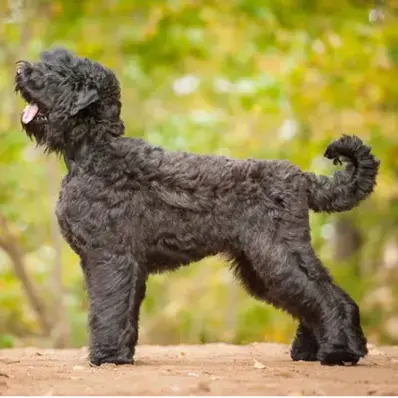








 Black Russian Terrier- Source:
Black Russian Terrier- Source: 


